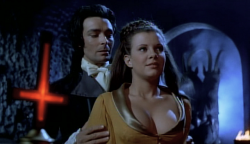Reviews
Le Rouge aux Lèvres
Harry Kümel
Belgium, 1971
Credits
Review by Michael Nordine
Posted on 21 February 2011
Source Blue Underground DVD
Categories Lesbian Vampires
A confession: depending on one’s definition of the term, I don’t frequently indulge in cult cinema. I am, for instance, well-versed in The Big Lebowski and Repo Man—both of which have become so popular since attaining cult status as to hardly qualify anymore—but have never been to a midnight screening of The Rocky Horror Picture Show or even seen Pink Flamingos. This doesn’t stem from elitism; I tend to watch one movie every day and have so much repertory viewing to catch up on that I simply find it difficult to make time for films I’m not embarrassed about having not yet seen. My decision to participate in the lesbian vampire feature was thus more out of morbid curiosity and the fact that this website promotes filmic intrepidity than a genuine interest in this particular sub-sub-genre. Indeed, vampires ranked rather low on my list of fantastical creatures even before they started twinkling in sunlight. (I’m more of a zombie guy.) All this to say that, cynic that I am, I did not expect much more than novelty from Daughters of Darkness. Shame on me. Imperfect though it may be, this film is as strong a reminder as Chinatown that fascinating cinema won’t find you on its own; it must be sought out.
What first warrants mention is the film’s subtle take on its often-misused source material. The Hungarian countess Báthory Erzsébet has always proved a fascinating figure - something to which any number of metal bands, books, and lesser films can attest - and the tendency in Báthory-inspired media is most often to milk her misdeeds for all their dark intrigue. Not so in Daughters; director Harry Kümel opts for a far more restrained invocation of her legend than might be expected. Perhaps the only exception to this rule, albeit a well-executed one, occurs when the newlywed Stefan provides a history lesson for anyone unfamiliar with Báthory’s long list of crimes:
She believed human blood was the elixir of youth. She kidnapped young girls and kept them chained to give blood… blood for her to bathe in and drink. Then she hung them up by the wrists and whipped them until their tortured flesh was torn to shreds. She pricked their bodies with needles and she bit them everywhere. Then she pushed white-hot pokers into their faces. And when they parted their lips to scream she shoved the flaming rod up into their mouths. She pierced their veins with rusty nails and slit their throats.
In terms of dialogue, this is as explicit as Daughters of Darkness gets. It occurs when Báthory herself - played by a pre-Jeanne Dielman Delphine Seyrig - meets Stefan and his new bride Valerie for drinks in the lounge of the seaside hotel in which they are seemingly the only guests. Mystery surrounds the regally-dressed and strikingly blonde Báthory, who immediately arouses curiosity from Valerie and Stefan. The apparently ageless countess, who claims to only be a descendant of herself, invites the attention (Daughters of Darkness is presumably set in or near 1971, the year of its release). As Stefan recounts her crimes in sickening detail, two things occur simultaneously: Valerie repeatedly screams for him to stop and Báthory urges him to continue, suggestively touching his chest from behind all the while. Even here, in a moment more overtly sexual than some of the film’s actual sex scenes, Kümel shows restraint in cutting the moment short.
Sex and death are linked in Daughters of Darkness. “Don’t lie to me. It gave you pleasure. You actually enjoyed seeing that girl’s dead body,” Valerie says to Stefan in what seems a moment of foreshadowing but ultimately becomes one of misdirection. And herein lies the real intrigue: the darkest elements of the film aren’t there for their own sake, but rather to intimate subtle aspects of the characters. These characters aren’t looking for a sadistic romp; they each have their own needs and desires, often with conflicting means of acquiring them. As a result, the transformations they undergo are far more subtle than human into vampire.
Where the film announces itself most loudly, then, is in its visuals: vibrant red veils laid over lampshades; sharp blacks and whites; and the comparatively desaturated grays and blues of early morning on the ocean. Though striking, the imagery tends to work alongside the goings on rather than dominate them, and the seamless transitions between the many colors in cinematographer Eduard van der Enden’s palette make for a frequently visually arresting experience.
Which isn’t to say that Kümel isn’t susceptible to genre tropes; he is. For instance: the unsuspecting Valerie foreshadows latter happenings by reading of troubling events in a newspaper; quick camera cutaways are often accompanied by (sometimes successful) attempts at jarring, off-kilter keyboard music courtesy of François de Roubaix; and even a shot eerily reminiscent of the hand reaching out of the grave in Night of the Living Dead. Conversely, the film’s blood-curdling screams are few and far between, and never unwarranted. For a film drawing on the mythology of a woman whose supposedly bathed in the blood of hundreds of virgins, Daughters of Darkness is disarmingly modest in both its small number of victims and the methods of their dispatch. Not a single death is drawn out for effect—indeed, most aren’t even on purpose.
More remarkable still, however, is what Kümel has to say about the power dynamics of a male-dominated relationship. “I am a man and she is mine,” Stefan at one point says of Valerie, and it’s true: despite being on their honeymoon, couples’ frequent quarrels (which arise for seemingly no rational reason, always on the part of Stefan) result in Stefan-on-Valerie violence on more than one occasion. He’s moody, distant, and in general treats his new wife poorly—and all this in the first few days of their marriage, no less. Once Valerie has had enough, however, a role reversal occurs, one seemingly brokered by Báthory herself. When, after an especially violent outburst, Valerie attempts to leave, her efforts are stymied by the countess. In the dark of night, Báthory asks a cutting question:
Whatever Stefan demands of you, do you consent to do it? Yes, naturally, but you don’t feel any pleasure.
The following will no doubt sound silly, but stay with me: lesbian-vampirism is the means by which Valerie frees herself from her abusive relationship with Stefan. Though attempting to use Valerie for her own ends, Báthory is still the catalyst for Valerie’s liberation. “Why did she cross our path?” Valerie asks Stefan in reference to the countess. “I become something different when she is near.” Báthory is ultimately most notable for inviting introspection on the part of Valerie. “One must never be afraid to look deep down into the darkest depths of oneself,” she says, “where the light never reaches.” That Valerie is set up from the beginning of Daughters as its most likely victim but (spoilers herein) ultimately supplants Báthory herself as head of the brood is the sort of development that can retroactively alter one’s understanding of the film as whole.
Ultimately, the film’s relative obscurity is unsurprising insofar as it exists on the fringes of both mainstream and cult cinema. Too transgressive for the former, too tame for the latter, it occupies an in-between state that only makes it more fascinating—Daughters of Darkness upturns more genre conventions than it follows. It is neither a bloodbath nor a thinly-veiled morality tale; its candle burns slowly, and from only one end. The resultant half-light is fitting: title notwithstanding, Daughters of Darkness shows itself to be a strange beast fit for neither light not dark.
More Lesbian Vampires
-

Rape of the Vampire
1968 -

The Vampire Lovers
1970 -

Lust for a Vampire
1971 -

Twins of Evil
1971 -

Vampyros Lesbos
1971 -

Daughters of Darkness
1971 -

The Blood Spattered Bride
1972 -

Vampyres
1974
We don’t do comments anymore, but you may contact us here or find us on Twitter or Facebook.



